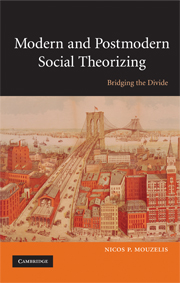Book contents
- Frontmatter
- Contents
- List of figures
- Acknowledgements
- Introduction
- Part I The theoretical background: the development of the agency–structure problematic
- Part II Parsonian and post-Parsonian developments
- 2 Parsons and the development of individual rights
- 3 Evolution and democracy: Parsons and the collapse of communism
- 4 Post-Parsonian theory I: neo-functionalism and beyond
- 5 Post-Parsonian theory II: beyond the normative and the utilitarian
- Part III Agency and structure: reworking some basic conceptual tools
- Part IV Bridges between modern and late/postmodern theorizing
- Part V Towards a non-essentialist holism
- Instead of Conclusion: Twelve rules for the construction of an open-ended holistic paradigm
- Appendix: In defence of ‘grand’ historical sociology
- References
- Index
5 - Post-Parsonian theory II: beyond the normative and the utilitarian
Published online by Cambridge University Press: 05 June 2012
- Frontmatter
- Contents
- List of figures
- Acknowledgements
- Introduction
- Part I The theoretical background: the development of the agency–structure problematic
- Part II Parsonian and post-Parsonian developments
- 2 Parsons and the development of individual rights
- 3 Evolution and democracy: Parsons and the collapse of communism
- 4 Post-Parsonian theory I: neo-functionalism and beyond
- 5 Post-Parsonian theory II: beyond the normative and the utilitarian
- Part III Agency and structure: reworking some basic conceptual tools
- Part IV Bridges between modern and late/postmodern theorizing
- Part V Towards a non-essentialist holism
- Instead of Conclusion: Twelve rules for the construction of an open-ended holistic paradigm
- Appendix: In defence of ‘grand’ historical sociology
- References
- Index
Summary
Introduction
Alexander has tried to restructure Parsonian theory by reworking the theory of culture and by exploring the connections between culture and action in novel ways. Hans Joas, on the other hand, in his influential The Creativity of Action (1996), tries to go beyond Parsons by putting at the centre of his analysis not the normative but the creative, not the actor but interaction.
According to Joas, Parsons' early work, particularly his The Structure of Social Action (1937), set the foundations for all subsequent sociological attempts to construct a general theory of action. For Joas, however, these foundations are rather inadequate. They have directed the attention of social theorists to the utilitarian–normative or rational–non-rational distinction, which leads to a very restrictive conceptual framework. This framework rules out the idea that what is most distinctive about human action is neither rationality nor normativeness but creativity, which underlies and goes beyond the notions of the rational and the normative.
Parsons' critique of utilitarianism and his persistent attempt to show the normative basis of social order (which is to say, his one-sided concern with the rational–normative dialectic) prevented him from taking into consideration various philosophical theories of action that grapple with the issue of creativity. It also prevented him from seeing what the theorists on whom he focused (Pareto, Marshall, Durkheim, Weber and, to a lesser extent, Tönnies and Simmel) had to say about the creative, inventive aspects of action.
- Type
- Chapter
- Information
- Modern and Postmodern Social TheorizingBridging the Divide, pp. 86 - 94Publisher: Cambridge University PressPrint publication year: 2008

